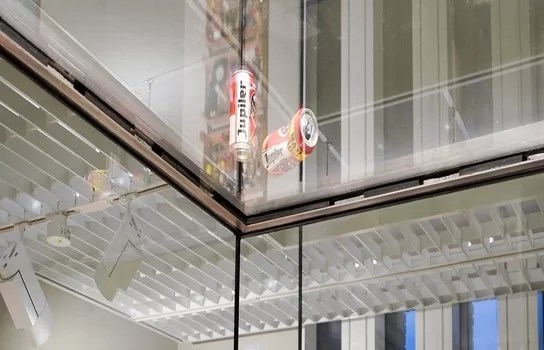Lift Technician Mistakes Museum Artwork for Trash
A humorous mix-up occurred at the LAM Museum in Lisse, Netherlands, when a lift technician who was unfamiliar with the museum’s unconventional art placements, mistook an artwork for rubbish and threw it away. The artwork in question, All the good times we spent together by French artist Alexandre Lavet, was discovered in a bin bag—luckily still intact—before being saved from its unintended fate.
An Artful Deception: Lavet’s Meticulous Creation
On the surface, Lavet’s piece appears to be nothing more than two crumpled beer cans. However, these are no ordinary objects; they are meticulously hand-painted with acrylics, each dent and detail carefully replicated. Lavet’s work blurs the line between reality and art, challenging perceptions and prompting viewers to look beyond the surface.

Unlike readymade objects such as the famous urinal attributed to Elsa von Freytag-Loringhoven and Marcel Duchamp, Lavet’s piece is a painstaking creation meant to evoke the simple yet significant moments of friendship.
The beer cans, which symbolise evenings spent with close friends, were placed inside the museum’s glass lift shaft as if abandoned by construction workers—a playful nod to the museum’s unique approach. The LAM Museum, known for showcasing its international art collection in unexpected places, embraces this strategy as part of its thematic focus on food and consumption.
An Honest Mistake: The Museum’s Response

The museum’s director, Sietske van Zanten, expressed understanding about the incident. “The technician was covering for our regular lift technician, who is familiar with our building and exhibits. He was just doing his job in good faith,” she said.
Rather than being upset, she noted that the technician’s action highlighted the effectiveness of Lavet’s art in deceiving viewers, even experienced professionals.
The museum appreciates how the piece sparked curiosity and underscored its mission to challenge conventional perspectives.
A Swift Recovery and Unexpected Outcome
The alarm was raised when curator Elisah van den Bergh noticed the artwork missing. After a thorough search, she discovered the cans in a bin bag, ready for disposal. Fortunately, the artwork was found undamaged, and the museum acted swiftly to restore it.
In a celebratory gesture, the museum has temporarily placed the cans at the entrance on a traditional plinth, a departure from their original setting.
“We wanted to give them their moment in the spotlight,” van den Bergh explained, noting that the museum enjoys playing with space and location to keep visitors engaged. “As for where they’ll be displayed next, we like to keep that a surprise—no space is off-limits.”
Readymade Artistic Impact

The incident has inadvertently amplified the message behind Lavet’s work.
By being mistaken for everyday objects and nearly discarded, the artwork has further illustrated how mundane items can hold deeper meanings and evoke connections when viewed through a different lens.
The LAM Museum continues to push these boundaries, reminding visitors that art can appear in the most unexpected places—even the rubbish bin.
Readymade art is a revolutionary concept in modern art, first popularized by artists like Marcel Duchamp in the early 20th century. It involves taking ordinary, often mass-produced objects and presenting them as art, fundamentally challenging traditional notions of artistic skill and creation.
Duchamp’s famous piece Fountain, a porcelain urinal he signed and submitted to an art exhibition in 1917, remains a defining example. By choosing objects that were not originally designed as art, readymades provoke viewers to question the role of the artist, the value of the object, and the very definition of what constitutes art itself. This approach shifts the focus from technical skill or aesthetic beauty to the artist’s intention and the context in which the object is presented.
The impact of readymade art extends far beyond its initial shock value; it has become a crucial part of the dialogue around conceptual art. By elevating everyday objects to the status of art, readymades blur the line between the ordinary and the extraordinary, prompting viewers to reconsider the world around them and the hidden significance of common items.
This genre of art also invites discussions on authorship and originality, as the artist’s role becomes one of selection and recontextualization rather than creation. Readymades laid the groundwork for many contemporary art practices, influencing movements like Dadaism and Pop Art, and continue to challenge and inspire artists today as they explore the boundaries of art in new, often provocative, ways.
Related stories
Man Ray’s love-hate relationship with Hollywood
Advertisement:




